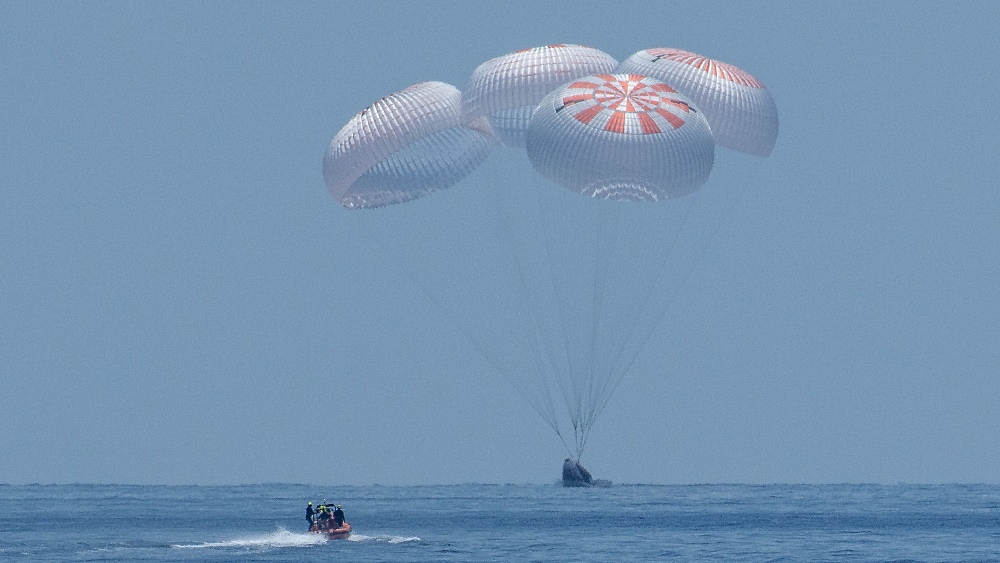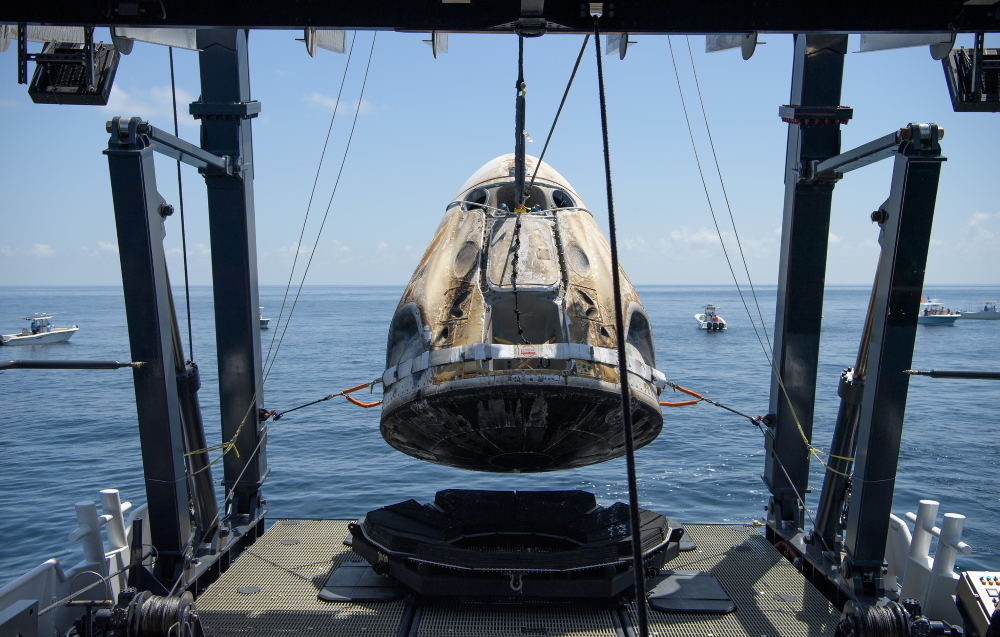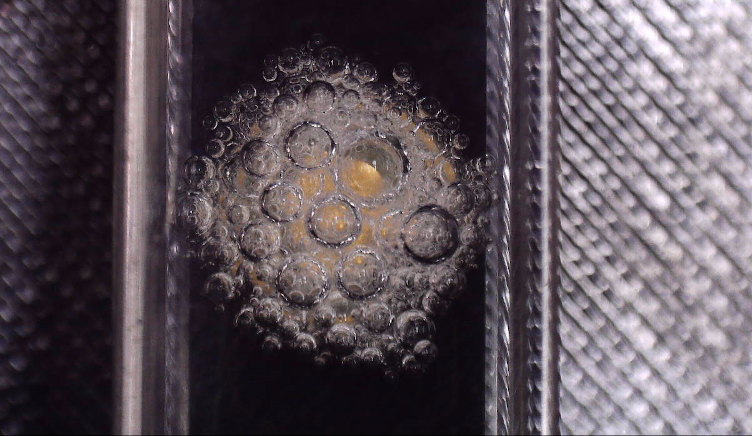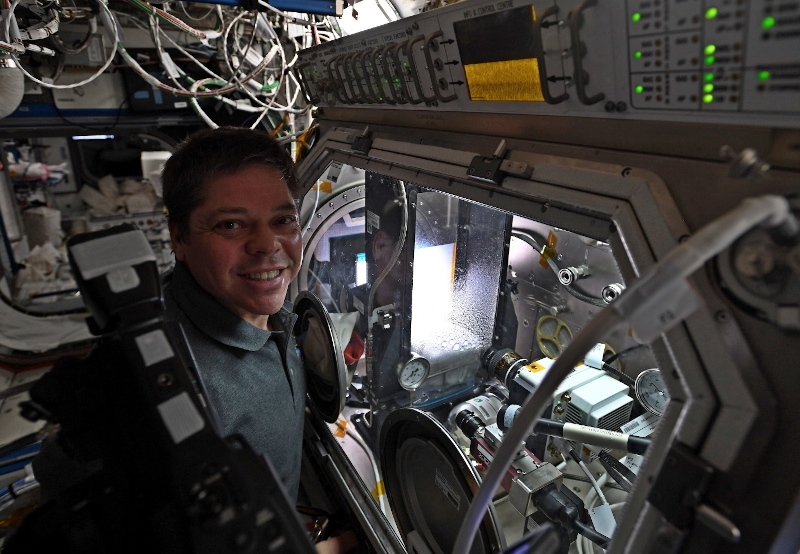
Crew Dragon flood, photo NASA / Bill Ingalls
Landing

Photo by NASA / Bill Ingalls
Crew Dragon undocked from the ISS at 23:35 UTC on 1 August. The spacecraft then performed four planned withdrawal maneuvers to move away from the station and not intersect with it in the next orbits, and a phasing maneuver, which lasted six minutes and formed an orbit passing over the landing site at the right time. On August 2 at 17:51 UTC, the service module with solar panels and heat sinks was dropped. At 17:56, an eleven-minute braking impulse began. The ship entered the atmosphere after 18:11, passed the controlled deceleration area in the dense layers of the atmosphere, deployed the braking parachutes at 18:44, main parachutes at 18:45, and made a successful splashdown at 18:48 near the Gulf Coast. Then the ship was lifted aboard the Go Navigator, and after a short pause caused by the detection of toxic fuel components outside the ship,opened the hatch and evacuated the astronauts.

NASA/Bill Ingalls

, NASA
In two months, the Crew Dragon crew took part in four spacewalks. In all cases, the extravehicular activities were carried out by Bob Behnken and Chris Cassidy, who arrived on the ISS on Soyuz MS-16 on April 9. Three of the four EVAs were associated with the completion of a more than three-year campaign to replace the station's batteries from old nickel-hydrogen batteries with new lithium-ion ones - two old batteries are replaced with one new one with an adapter. On June 26, in six hours and seven minutes, Bob and Chris removed five of the six nickel-hydrogen batteries on the first bus of the starboard S6 truss and installed two of the three lithium-ion batteries with adapters. On July 1, during the second spacewalk, we finished work on the first bus, removing the last old battery and installing a new one.We also carried out preparatory work to replace the batteries of the second tire - we loosened the fasteners of the old batteries. EVA took six hours and one minute. And on July 16, the work was completed - on the second bus, six old batteries were removed and replaced with three new ones with adapters. In total, 48 old batteries were replaced with 24 new ones in three and a half years. But that's not all - in April 2019, one of the new batteries failed, two old ones were temporarily returned, and now a replacement battery, brought in this January, is waiting on the truss.Two old ones were temporarily returned, and now a replacement battery, brought in this January, is waiting on the truss.Two old ones were temporarily returned, and now a replacement battery, brought in this January, is waiting on the truss.
The fourth spacewalk took six and a half hours. Behnken and Cassidy installed a container with two external ammonia leak sensors for the Canadian robot Dextr (two-handed robot, an extension of the Canadarm2 manipulator). Ammonia is used in the cooling system of the American segment and, for example, in 2013 the crew discovered a leak from snowflakes flying away from the station. The lower attachments of the solar panels of the near truss of the left side were also removed - they were used on the ground in preparation for flight and are no longer needed. The ISS Tranquility module was prepared for the installation of a commercial load gateway, which will be delivered later. The gateway will allow commercial or government experiments to be launched into space. Well, on the little things, we laid the cables of the local network of the station and removed the filter on the external camera.As a result, Bob and Chris became the third and fourth American astronauts to credit 10 spacewalks.
The science
The International Space Station is an interesting place. For example, you can crush a fruit punch in the name of science.

And this is not a game with food, but a potentially very useful experiment in filling capillary foam structures (Capillary Structures Infill). The fact is that in zero gravity it is not so easy to separate liquid and gas; now rotating or moving structures are used for this. And the fact that Doug Hurley successfully squeezed the drinking bag with uniform efforts in about fifteen seconds into a test foam mold could in the future lead to lighter and more reliable life support systems, where capillary structures will, for example, separate moisture from exhaled air or even be used in systems absorption of carbon dioxide.

Photo by NASA
Bob and Doug also actively bubbled the electrolysis unit, changing test samples and recording results. For all its apparent simplicity, this experiment can lead, for example, to the creation of more effective patches for drug delivery through the skin.

Photo by NASA
I was at the station and, if I may say so, the opposite experiment - in a special Microgravity Science Glovebox, the formation of drops in zero gravity from the Delta Faucet's H2Okinetic shower head was studied. Nowadays, to save water, showerhead designs often reduce the flow of water. But people notice that the new showerheads seem to work worse, and take longer showers, making the idea of saving naught. Until now, not all of the effects of gravity on the formation of water droplets have been studied, so this experiment may lead to more sustainable showers.
Of course, the astronauts were doing maintenance work, for example, they had to temporarily rent the station's Advanced Plant Habitat Facility to get to what is behind it. Also installed in the Columbus module is a new European Drawer Rack Mark 2 experiment cabinet delivered by the recent HTV cargo ship mission. And, of course, we took part in the ongoing experiment on Earth observation - the result is not only very beautiful, but also useful for science, despite the abundance of meteorological satellites, photographs.